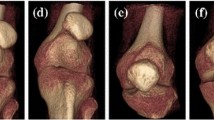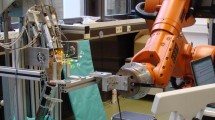Abstract
Opto-electronic cinematic analysis has already proven useful in the investigation of patients with a knee replacement; however, neither patellar tracking nor the various positional parameters relevant to instability such as patellar tilt and/or patellar shift have ever been specifically evaluated using this type of system. The aim of this research was to validate the relevance of this type of cinematic analysis in order to use it in the evaluation of the main factors underlying patellar instability. Six fresh-frozen anatomical specimens were studied. The data were acquired using the Motion Analysis® system. Statistical analysis reveals a good reproducibility of measurements. Our protocol based on an opto-electronic acquisition system has an accuracy of 0.23 mm for shift and of 0.4° for rotation, which is calculated by integrating the various experimental parameters and instrumental features specific to the Motion Analysis® system. The results are consistent with published results which further attests to the validity and the efficacy of the protocol and encourages us that this protocol is suitable for the in vitro study of patellar kinematics.






Similar content being viewed by others
References
Ahmed AM, Duncan NA, Tanzer M (1999) In vitro measurement of the tracking pattern of the human patella. J Biomech Eng 121:222–228
Asano T, Akagi M, Koike K, Nakamura T (2003) In vivo three-dimensional patellar tracking on the femur. Clin Orthop Relat Res 413:222–232
Bonnefoy A, Pradon D, Cheze L (2005) Les systemes d’analyse du mouvement: techniques et principes, protocoles, sources d’erreurs et solutions. ITBM-RBM News 26(6):24–32
Brossmann J, Muhle C, Schröder C, Melchert UH, Büll CC, Spielmann RP, Heller M (1993) Patellar tracking patterns during active and passive knee extension: evaluation with motion-triggered cine MR imaging. Radiology 187:205–212
Bull AM, Katchburian MV, Shih YF, Amis AA (2002) Standardisation of the description of patellofemoral motion and comparison between different techniques. Knee Surg Sports Traumatol Arthrosc 10:184–193
Della Croce U, Cappozzo A (2000) A spot-chek for estimating stereophotogrammetric errors. Med Biol Eng Comput 38:260–266
Grood ES, Suntay WJ (1983) A joint coordinate system for the clinical description of three-dimensional motions: application to the knee. J Biomech Eng 105:136–144
Harman M, Dogan A, Arslan H, Ipeksoy U, Vural S (2002) Evaluation of the patellofemoral joint with kinematic MR fluoroscopy. Clin Imaging 26:136–139
Heegaard J, Leyvraz PF, Curnier A, Rakotomanana L, Huiskes R (1995) The biomechanics of the human patella during passive knee flexion. J Biomech 28:1265–1279
Jenny JY, Lefèbvre Y, Vernizeau M, Lavaste F, Skalli W (2002) In vitro analysis of the continuous active patellofemoral kinematics of the normal and prosthetic knee. Rev Chir Orthop Reparatrice Appar Mot 88:797–802
Jenny JY, Lefèbvre Y, Vernizeau M, Lavaste F, Skalli W (2002) Validation of an experimental protocol of an optoelectronic analysis of continuous active knee kinematics in vitro. Rev Chir Orthop Reparatrice Appar Mot 88:790–796
Katchburian MV, Bull AM, Shih YF, Heatley FW, Amis AA (2003) Measurement of patellar tracking: assessment and analysis of the literature. Clin Orthop Relat Res 412:241–259
McGraw KO, Wong SP (1996) Forming inferences about some intraclass correlation coefficients. Psychol Methods 1(1):30–46
Nagamine R, Otani T, White SE, McCarthy DS, Whiteside LA (1995) Patellar tracking measurement in the normal knee. J Orthop Res 13:115–122
Reider B, Marshall JL, Ring B (1981) Patellar tracking. Clin Orthop Relat Res 157:143–148
Sakai N, Luo ZP, Rand JA, An KN (1996) Quadriceps forces and patellar motion in the anatomical model of the patellofemoral joint. Knee 3:1–7
Sandmeier RH, Burks RT, Bachus KN, Billings A (2000) The effect of reconstruction of the medial patellofemoral ligament on patellar tracking. Am J Sports Med 28:345–349
Author information
Authors and Affiliations
Corresponding author
Rights and permissions
About this article
Cite this article
Philippot, R., Chouteau, J., Testa, R. et al. In vitro analysis of patellar kinematics: validation of an opto-electronic cinematic analysis protocol. Knee Surg Sports Traumatol Arthrosc 18, 161–166 (2010). https://doi.org/10.1007/s00167-009-0956-0
Received:
Accepted:
Published:
Issue Date:
DOI: https://doi.org/10.1007/s00167-009-0956-0




